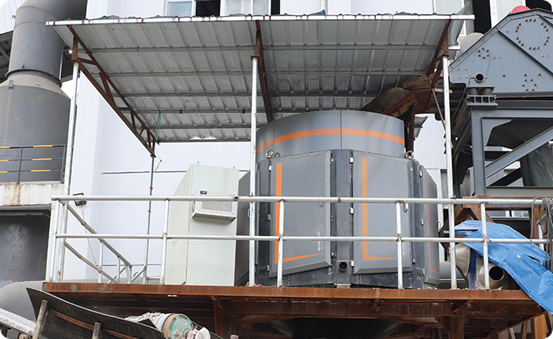Xintianling Wolfram Mine in China has partnered with HPY Technology to upgrade the ore content and reduce the amount of tailings being processed at its operation in China.
Established in 2008, Hunan Nonferrous Metals Xintianling Wolfram Mine Co., Ltd. (Xintianling Wolfram Mine) represents the largest individual producer of tungsten concentrate in China. With a processing capacity of 1.5 Mt of ore, the mine produces 5,000 t of tungsten concentrate annually. The company is engaged in mining, beneficiating and tungsten ore sales, along with molybdenum and bismuth recovery.
Xintianling Wolfram Mine is a subsidiary of China Tungsten and Hightech Materials Co. Ltd., which is the management and operation platform for the tungsten industry owned by China Minmetals Corporation. A Fortune 500 company, China Minmetals manages and operates a complete tungsten industry chain that integrates mining, smelting, processing and trading. Its management area contains 1.23 Mt of tungsten resources, representing approximately 11% of China’s identified tungsten resources, according to the company. Its annual production capacity for tungsten smelting reaches 20,000 t, constituting 10% of the total capacity for ammonium paratungstate in China.
In its early years, Xintianling Wolfram Mine used shorthole blasting as the primary mining method. While this method leads to low ore depletion rates, it comes with drawbacks such as low mining efficiency, high costs, low mechanisation and high safety risks. In response to these challenges and production requirements of a 4,500 t/d reform and expansion project, the mine transitioned to medium-deep hole blasting methods for mining. This change, however, introduced issues of higher depletion rates, decreased ore grade and increased beneficiation production costs.
A significant challenge faced by the Xintianling Wolfram Mine is the production of over 1.3 Mt/y of tailings, consuming over 1 million sq.m of tailings reservoir capacity. With the existing tailings pond projected to meet production needs for only five more years, the mine needed to enrich the raw ore grade, reduce the amount of tailings entering the tailings pond, and lower the amount of material entering its grinding and flotation processes to adhere to its commitment to sustainable mining.
To tackle these problems, Xintianling Wolfram Mine partnered with HPY Technology in early 2021, seeking a method to solve its technical challenges and for a more sustainable process. HPY’s sensor-based ore sorting technology could help with these aspects, the technology company says. X-ray Transmission (XRT) detection is commonly used in the mining industry to analyse the atomic density differences in ores. XRT relies on the principles of X-ray absorption and attenuation to differentiate between various materials based on their atomic densities. The tungsten ore is first crushed into a smaller particle size, with the material then fed into the sorting machine, which uses X rays to detect differences in the ore. By measuring the degree to which the X rays are absorbed by the ore, the machine can distinguish between different types of material. As tungsten absorbs X rays very strongly due to its high atomic number and density, it is relatively easy to be identified through this method, according to HPY.
Even so, the raw ore of the Xintianling Wolfram has its own special characteristics. The mineral composition of the raw ore at the Xintianling Wolfram Mine is quite complex. Various minerals in the raw ore can be imaged under radiation, including tungsten minerals, metallic sulphides, iron minerals and denser gangue minerals. However, the most finely embedded tungsten cannot be captured and effectively identified in the image due to the varying particle sizes in the raw ore. Solving this problem requires high-precision imaging capture and ore identification by a sensor-based ore sorting machine. At the same time, the raw ore itself has a small particle size. Therefore, the image of the ore is relatively small, resulting in an increase in the amount of ore to be processed for the same processing capacity. It was a technical challenge for HPY to improve the processing capacity while maintaining a low waste rock grade and rejection rate.
HPY conducted on-site research, sampling, testing, simulation and analysis at the Xintianling Wolfram Mine. The Classic Series was used during the early stages of the experiment. The middle and later stages saw the introduction of the Circle Series – HPY Technology’s ring-shaped structure design that, the company says, allows for exceptional processing capacity within a compact frame. Through continuous optimisation of the software, modification of equipment adaptability, and fine-tuning of the artificial intelligence-based algorithm, the engineers succeeded in reducing the rejection rate and stabilising the waste rock grade, the company said. As a result, the experiment reached its desired goals and Xintianling Wolfram Mine was satisfied with the sorting results.
Ganzhou HPY Technology Co., Ltd., is a high-tech enterprise specialising in the development and manufacture of ore sorting machines. The company’s AI technology includes perception technology, human-computer interaction and deep learning. The performance of HPY’s technology in the Xintianling Wolfram Mine project demonstrates its effectiveness in addressing the challenges of sustainable mining, the company says.
Xintianling Wolfram | HPY Technology
| Particle size | +10-35 mm | Raw ore grade | 0.15%-0-40% WO3 |
| Rejection rate | 25% | Waste rock grade | 0.04% WO3 |
| Recovery rate | >94% | Processing capacity | 80-90 t/h |
| Enrichment ratio | >1.4 |











